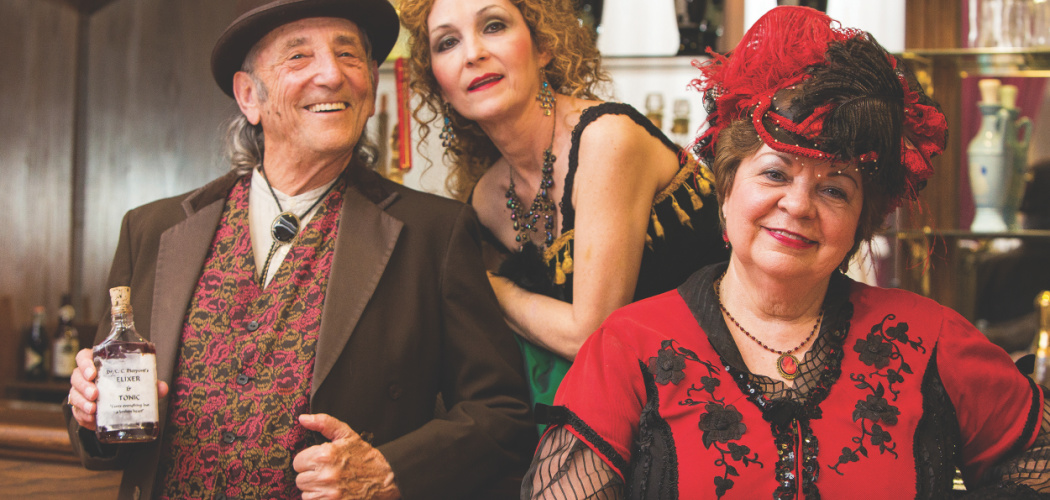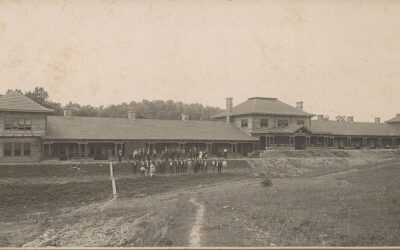[title subtitle=”WORDS Dwain Hebda
IMAGES courtesy Fort Smith Convention and Visitors Bureau”][/title]
The first and most obvious question to be asked of Carolyn Joyce, a woman who’s spent nearly thirty years impersonating one of Fort Smith’s most intriguing historic figures, Madame Laura Ziegler, rolls off the tongue with almost salacious delight.
What’s a nice girl like you doing in a role like this?
“Well, what was she thinking?” Carolyn says of herself, the sentence awash in a siren’s laugh. “It purely sprang from my imagination. I have no idea where it came from. As I was asked by the New York Times, ‘Did you take your [acting] training in New York?’ I said, ‘Uh, no. I grew up in a cotton patch in Brinkley, Arkansas, with four brothers.’ Growing up on the farm, I really wouldn’t want those people over in Brinkley knowing what I ended up doing.
“My husband used to say, ‘It certainly came naturally.’ I didn’t know if that was a positive or a negative.”
More laughter. More memories. A pause.
“It’s been a twenty-eight-year run and I mean that in every sense of the word,” she says, the satisfaction a bell in her voice. “It’s been an opportunity of a lifetime. I do not discount that whatsoever.”
Every town has a hundred stories, wispy strings of history that knit together to create the fabric of community and lore. Drought and flood, football wins and wartime losses, high cotton and low tides; each soak through the pages of time and place, ever-changing yet still somehow the same.
Miss Laura’s Social Club, however, is one strand of Fort Smith’s story that stands, as its namesake did, defiantly and resolutely its own, a single glittering thread in the community tapestry. The last surviving member of Bordello Row, the Social Club survived a century of the natural and moral forces that razed the red-light district’s six other houses of ill repute, from fire to hellfire. It withstood strafing by the 1996 tornado, floods in ‘43 and 2019, and narrowly missed the wrecking ball in 1963. Today, it’s completely restored and the only bordello to be on the National Register of Historic Places.
That the building is still here at all is an accomplishment that wouldn’t have happened without the work and commitment of many. But two figures stand out for having put the soul into the story of the house that gave the randy district its spark: Laura Ziegler, the Vermont prostitute-turned-entrepreneur who created the Social Club in 1903 and Carolyn who recreated Miss Laura herself in 1992.
“There is no picture of Miss Laura; she was here from 1898 until 1911. We zeroed in on that time frame,” Carolyn said. “This house was the queen of the row when all of the houses were operating. So, I felt like Miss Laura would have been a class act and that’s the way she needed to be portrayed.”
Frontier prostitution wasn’t a glamorous way to make a living, but Miss Laura’s Social Club represented the highest standards of service and hygiene the industry had to offer. Employees were strictly enjoined not to appear unclothed on the main floor, to maintain a more sophisticated atmosphere. They were required to complete regular medical examinations, from which Miss Laura posted their clean bills of health on the wall. She also kept the bawdy, party-like atmosphere within bounds, enforcing house rules as necessary with the occasional help from her companion Smith & Wesson.
For this reason, the Social Club was considered the jewel of Bordello Row, charging three times what the other houses did, at three dollars a session. Miss Laura had struck pay dirt, paying off in mere months the $3,000 initial loan she negotiated with a local bank to buy the former hotel building. But the party wouldn’t last; changing times, pressure from local reformers, and the deterioration of the neighborhood led Miss Laura to sell out in 1911 to her employee, Big Bertha Dean, for $47,000 before disappearing into history.
She wouldn’t be heard from again for nearly eighty years when Carolyn, employed by the city’s Convention and Visitor’s Bureau, brought her back. The context was different, of course, but the modus operandi was exactly the same: lure travelers into pulling over, having a good time and plunking down some money in the process.
“I realized pretty quickly that Fort Smith needed something to help get those motor coaches off the interstate,” she says. “They were going from Little Rock to Oklahoma City or vice versa, but they just were not coming into Fort Smith.
“I was looking for that marketing opportunity and came up with this idea and created the character so that I could talk to those tour operators when I went to the marketplaces. I told them, ‘If you’ll get off the interstate by Miss Laura’s I’ll be in costume to greet your group and give a tour of the old bordello.’ That’s how it started.”
It was an idea just crazy enough to work and in short order it did. In no time, Carolyn went from having to explain that Fort Smith existed to being a well-known figure in tourism industry circles, the sassy lady in the custom-made period costume complete with hat and jewelry.
“I did things like design my own business card in black and red, a card that was recognized and that they’d keep,” she says. “I had my own garment bags made for traveling that I carried my costumes in. On the garment bag it simply said, ‘Miss Laura, Fort Smith, Arkansas.’ Playing around with things like that, people just started to notice.”
“Those unfortunate ones that were seated next to me on airplanes, they had to hear all about Fort Smith from the time we left that airport to the time we arrived at the next one. Seriously, they knew all about Fort Smith by the time we landed.”
Carolyn’s gimmick proved irresistible and her Miss Laura persona took on a life of its own. In time she would commission more than twenty period costumes, custom-made for her life as Miss Laura both at the CVB and later for a musical comedy show she developed with other local actors.
“After portraying Miss Laura for a year or so I was going back to the tour operators saying, ‘I really enjoyed having your group in Fort Smith and giving them the tour. I’d love for you to stay overnight and spend more time with us. What can I do to help you make that decision?’” she says. “Their answer was immediately, ‘We have to have evening entertainment.’
“Therefore, Miss Laura’s Players was formed, and we started doing the musical comedy, The Medicine Show on Hanging Day. There were ten of us involved in that musical comedy and it ran for eighteen years.”
Her time as Miss Laura also yielded a lot of media attention both here and abroad, from CSPAN to QVC and the three major networks to print media of all shapes, sizes and readership.
“You had these media folks calling from around the country because they’ve heard about this woman down in Fort Smith who must be crazy because she’s running around portraying a madame. And they would pick up on that,” she says.
Between tour groups, media members, industry marketplaces and the stage, Carolyn estimates she has portrayed Miss Laura thousands of times over the years. But as much as she enjoyed the role, time waits for no madame and with the dampening effect of COVID, Carolyn decided to pack up her estimated $30,000 worth of costumes (all paid for out of her own pocket) and call it a career this fall. She doesn’t know what the future holds for her alter ego in retirement, but she knows the positive impact she’s made on behalf of her adopted hometown.
“When I started going to marketplaces, I had to take a map to show people where Fort Smith, Arkansas, was. I had to point, ‘I’m right here’ and I would circle it,” she says. “The thing I’m most proud of is the fact that I have put Fort Smith on the tourism map, not only around the nation but internationally as well. Folks are well aware of where Fort Smith is now.
“I have enjoyed portraying Miss Laura like I would have never imagined. If you had known me growing up in Brinkley, I was so bashful. Any of those folks that I went to school with would never think that I’d be standing in front of crowds performing, that’s for sure. I can tell you that all it really took was a costume and an attitude.”




